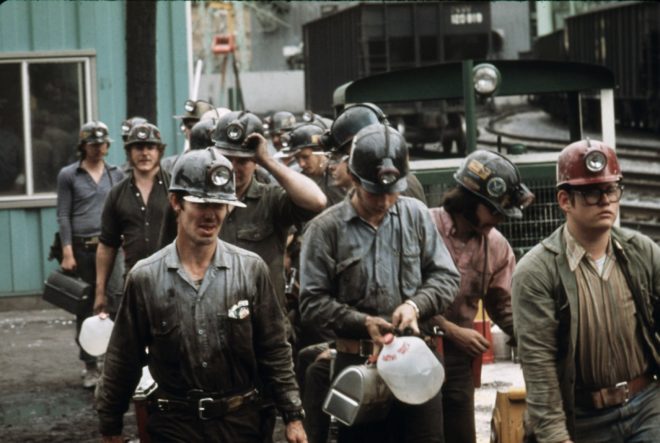Stop lying to coal miners and start preparing them for the jobs of the future
Donald Trump appeared in front of a podium on Tuesday to turn back the clock on America’s climate change agenda. That’s a big, if unfortunate, news story by itself, but what really got my attention was an anecdote that President Trump used toward the beginning of his speech (emphasis mine):
I want to acknowledge the amazing people behind me on this stage: Our incredible coal miners. We love our coal miners. Great people.
Over the past two years, I’ve spent time with the miners all over America. They told me about the struggles they’ve endured. I actually… went to a group of miners in West Virginia… and I said how about this: why don’t we get together, we’ll go to another place, and you’ll get another job. You won’t have to mine any more. Do you like that idea? They said ‘no, we don’t like that idea. We love to mine, that’s what we want to do.’ If that’s what you want to do, that’s what you’re going to do. …
The action I’m taking today will eliminate federal overreach, restore economic freedom, and allow our companies and our workers to thrive, compete, and succeed on a level playing field for the first time in a long time.
Doesn’t that sound like an admirable policy goal? Everyone gets to work in the field their parents worked in, that they grew up in, and that they trained for? And be able to compete in the global economy? It shouldn’t shock you that such a goal is unrealistic.
Here’s the hard truth for Trump and his administration: No amount of posturing, rhetoric, or symbolic gestures will bring back coal jobs. Those jobs are never coming back — no matter how many regulations Trump rolls back — because they never “left” in the first place. In its coverage of Trump’s new order, The New York Times succinctly summed up the problem:
The new order would mean that older coal plants that had been marked for closing would probably stay open for a few years longer, extending the demand for coal, said Robert W. Godby, an energy economist at the University of Wyoming.
But even so, “the mines that are staying open are using more mechanization,” he said. “They’re not hiring people,” he continued. “So even if we saw an increase in coal production, we could see a decrease in coal jobs,” he added.
So if these jobs are simply ceasing to exist, the real challenge that competent policymakers need to solve for is how to make these coal miners competitive in an economy that doesn’t need coal miners.
Job retraining is one of the most important issues in education today, but the U.S. government is barely acknowledging it — certainly not in comparison to the rest of the world. In a deep dive from The New York Times on a specific retraining program, WorkAdvance, the global divide is stark.
According to the Organization for Economic Cooperation and Development, the United States government spends only 0.03 percent of its gross domestic product on worker training. Denmark, whose policies to bring workers into work have gained praise around the world, spends proportionately almost 18 times as much. France spends 12 times as much; Germany seven times.
And, predictably, we’re getting what we pay for. The same coal miners (and truckers, and assembly line workers) that Trump trots out to promote his agenda are the same ones who are going to be put out of work while the administration continues to tout how it’s making America great again. And every day that coal miners are sitting, waiting for their jobs to come back is another day that they are falling behind workers from around the world who are acclimating to the information economy.
So what could an effective administration do to make progress on this front? A few things come to mind:
- Tone down the rhetoric, and change the conversation: No administration can bring back the economy of the 1950’s, so the best path forward is to stop, acknowledge this, and propose actionable solutions. Yes, Trump would get flak for going back on his campaign rhetoric, but such is the responsibility of credible policymakers — sometimes you need to give out harsh medicine (and take the heat for it) in return for helping people down the road.
- Create dedicated bootcamps for threatened industries: If Trump wants to put America first, then he should be working with tech companies to onboard this next wave of American workers into the modern economy. I recalled an article from Lauren Smiley in Backchannel a couple years ago in this very field that asked a simple question: “Can you teach a miner how to code?” Answered simply: yes! Bit Source, and other startups like it, have proved that they can thrive in the Rust Belt, Appalachia, and elsewhere in the United States — teaching workers in threatened industries skills that can make them competitive in the global economy. Sure we could wait for them to arise naturally, but this administration should have a strong interest in helping this process along.
- Encourage more effective secondary and college education: The best way to avoid retraining is to train well in the first place — that is, to ensure students are graduating with their best foot forward in competitive fields of work. The administration’s rhetoric on education, particularly on STEM, has been troubling to say the least, and Betsy DeVos does not seem to be the ideal leader for this initiative. However, this is what an effective administration should do.
Will President Trump take on any of these actions on his own accord? Probably not. So it should be the responsibility of all citizens to push our elected officials toward smart policy solutions for retraining the segments of our workforce that are most threatened by obsolescence.
